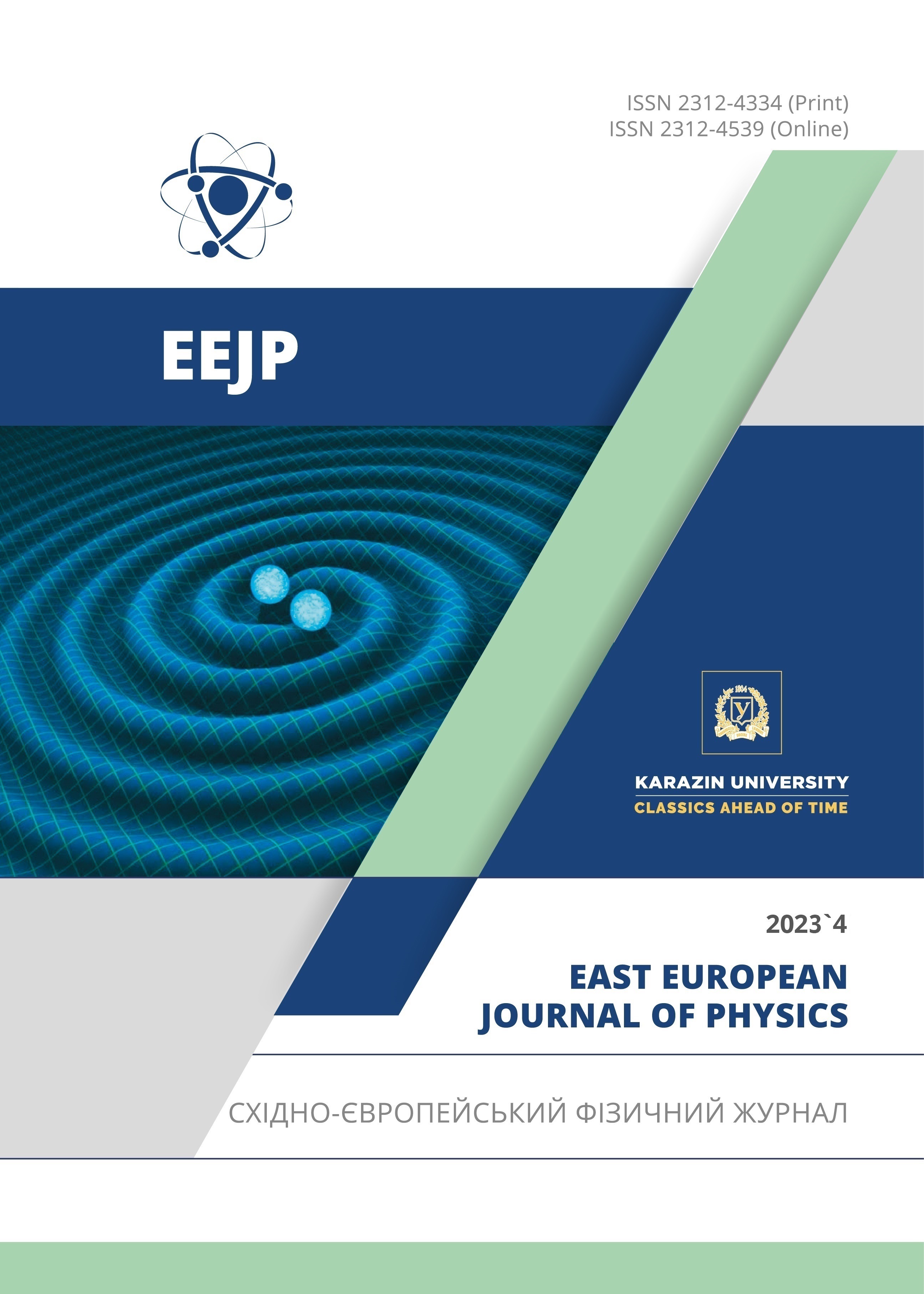The Mechanism of the Formation of Binary Compounds Between Zn and S Impurity Atoms in Si Crystal Lattice
Abstract
The paper presents the results of an experimental study of surface morphology, elemental composition, electrophysical and optical properties of Si samples earlier doped with impurity atoms of Zn and S. The results of the study revealed a sufficient concentration of Zn and S elements on Si surface after diffusion (3.1% and 2.6% by weight, respectively). After additional thermal treatment at different temperatures, i.e., at 850°C and 875°C, the samples of I group have regained their initial parameters. However, it’s noteworthy that the mobility of charge carriers in group I samples was comparatively lower than that in group II samples allegedly under the influence of Zn and S binary molecules. After additional heat treatment of all samples at a temperature of 875°C, the authors have studied optical absorption coefficients. And their band gap energies were determined using the Tauc Plot method. According to the results of the study, the optical band gaps in group II and III samples were 1.12 eV, whereas the band gap energy in group I samples after additional thermal treatment at a temperature of 875 °C turned out to be 1.31 eV. Having theoretically calculated the band gap by applying Vegard’s law, the authors suggested that the new structure must be of Si0.92ZnS0.08 - type.
Downloads
References
J. McCloy, and R. Tustison, Chemical vapor deposited zinc sulfide, (SPIE The International Society for Optical Engineering, Bellingham, Washington USA, 2013).
J. Liu, and S. Yue, “Fabrication of ZnS layer on silicon nanopillars surface for photoresistor application,” Chemical Physics Letters, 801, 139716 (2022). https://doi.org/10.1016/j.cplett.2022.139716
J. Kang, J.-S. Park, P. Stradins, and S.-H. Wei, “Nonisovalent Si-III-V and Si-II-VI alloys: Covalent, ionic, and mixed phases,” Physical Review B, 96, 045203 (2017). https://doi.org/10.1103/PhysRevB.96.045203
V.H. Choudapura, S.B. Kapatkara and A.B. Raju, “Structural and optoelectronic properties of zinc sulfide thin films synthesized by co-precipitation method,” Acta chemica IASI, 27(2), 287-302 (2019). https://doi.org/10.2478/achi-2019-0018
H.J. Xu, H.S. Jia, Z.T. Yao, and X.J. Lia, “Photoluminescence and I–V characteristics of ZnS grown on silicon nanoporous pillar array,” J. Mater. Res. 23(1), 121–126 (2008). https://doi.org/10.1557/JMR.2008.0005
J. Díaz-Reyes, R.S. Castillo-Ojeda, R. Sanchez-Espíndola, M. Galvan-Arellano, and O. Zaca-Moran, “Structural and optical characterization of wurtzite type ZnS,” Current Applied Physics, 15, 103e109 (2015). http://dx.doi.org/10.1016/j.cap.2014.11.012
M. Özkan, N. Ekem, S. Pat, M.Z. and Balbağ, “ZnS thin film deposition on Silicon and glass substrates by Thermionic vacuum Arc,” Materials Science in Semiconductor Processing, 15, 113–119 (2012). https://doi.org/10.1016/j.mssp.2011.07.004
X.M. Iliyev, S.B. Isamov, B.O. Isakov, U.X. Qurbonova, and S.A. Abduraxmonov, “A surface study of Si doped simultaneously with Ga and Sb,” East Eur. J. Phys. 3, 303 (2023). https://doi.org/10.26565/2312-4334-2023-3-29
X.M. Iliyev, V.B. Odzhaev, S.B. Isamov, B.O. Isakov, B.K. Ismaylov, K.S. Ayupov, S.I. Hamrokulov, and S.O. Khasanbaeva, “X-ray diffraction and raman spectroscopy analyses of GaSb-enriched Si surface formed by applying diffusion doping technique,” East Eur. J. Phys. 3, 363 (2023), https://doi.org/10.26565/2312-4334-2023-3-38
D.C. Onwudiwe, J.O. Adeyemi, R.T. Papane, F.F. Bobinihi, and E. Hosten, “Synthesis, optical and structural characterisation of ZnS nanoparticles derived from Zn(II) dithiocarbamate complexes,” Open Chemistry, 19, 1134–1147 (2021). https://doi.org/10.1515/chem-2021-0094
N.F. Zikrillaev, G.A. Kushiev, S.V. Koveshnikov, B.A. Abdurakhmanov, U.K. Qurbonova, and A.A. Sattorov, “Current status of silicon studies with GexSi1-x binary compounds and possibilities of their applications in electronics,” East Eur. J. Phys. 3, 334 (2023). https://doi.org/10.26565/2312-4334-2023-3-34
N.F. Zikrillaev, G.A. Kushiev, S.I. Hamrokulov, and Y.A. Abduganiev, “Optical Properties of GexSi1–x Binary Compounds in Silicon,” Journal of Nano-and Electronic Physics, 15(3), (2023). https://doi.org/10.21272/jnep.15(3).03024
W. Macyk, “How to Correctly Determine the Band Gap Energy of Modified Semiconductor Photocatalysts Based on UV−Vis Spectra,” J. Phys. Chem. Lett. 9, 6814−6817 (2018). https://doi.org/10.1021/acs.jpclett.8b02892
M. Merli, and A. Pavese, “Beyond the Vegard’s law: solid mixing excess volume and thermodynamic potentials prediction, from end-members,” Physics Letters A, 384(2), 126059 (2020). https://doi.org/10.1016/j.physleta.2019.126059
Copyright (c) 2023 Nurulla F. Zikrillaev, Maruf K. Khakkulov, Bobir O. Isakov

This work is licensed under a Creative Commons Attribution 4.0 International License.
Authors who publish with this journal agree to the following terms:
- Authors retain copyright and grant the journal right of first publication with the work simultaneously licensed under a Creative Commons Attribution License that allows others to share the work with an acknowledgment of the work's authorship and initial publication in this journal.
- Authors are able to enter into separate, additional contractual arrangements for the non-exclusive distribution of the journal's published version of the work (e.g., post it to an institutional repository or publish it in a book), with an acknowledgment of its initial publication in this journal.
- Authors are permitted and encouraged to post their work online (e.g., in institutional repositories or on their website) prior to and during the submission process, as it can lead to productive exchanges, as well as earlier and greater citation of published work (See The Effect of Open Access).








